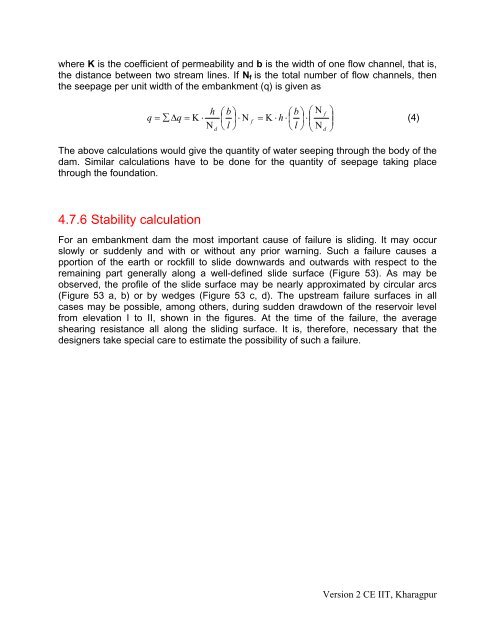Lesson 7 - nptel
Lesson 7 - nptel
Lesson 7 - nptel
You also want an ePaper? Increase the reach of your titles
YUMPU automatically turns print PDFs into web optimized ePapers that Google loves.
where K is the coefficient of permeability and b is the width of one flow channel, that is,<br />
the distance between two stream lines. If Nf is the total number of flow channels, then<br />
the seepage per unit width of the embankment (q) is given as<br />
h ⎛ b ⎞<br />
⎛ b ⎞ ⎛ Ν f ⎞<br />
q = ∑ Δq<br />
= Κ ⋅ ⎜ ⎟ ⋅ Ν = Κ ⋅ ⋅⎜<br />
⎟ ⋅<br />
⎜<br />
⎟<br />
f h<br />
(4)<br />
Ν d ⎝ l ⎠<br />
⎝ l ⎠ ⎝ Ν d ⎠<br />
The above calculations would give the quantity of water seeping through the body of the<br />
dam. Similar calculations have to be done for the quantity of seepage taking place<br />
through the foundation.<br />
4.7.6 Stability calculation<br />
For an embankment dam the most important cause of failure is sliding. It may occur<br />
slowly or suddenly and with or without any prior warning. Such a failure causes a<br />
pportion of the earth or rockfill to slide downwards and outwards with respect to the<br />
remaining part generally along a well-defined slide surface (Figure 53). As may be<br />
observed, the profile of the slide surface may be nearly approximated by circular arcs<br />
(Figure 53 a, b) or by wedges (Figure 53 c, d). The upstream failure surfaces in all<br />
cases may be possible, among others, during sudden drawdown of the reservoir level<br />
from elevation I to II, shown in the figures. At the time of the failure, the average<br />
shearing resistance all along the sliding surface. It is, therefore, necessary that the<br />
designers take special care to estimate the possibility of such a failure.<br />
Version 2 CE IIT, Kharagpur

















